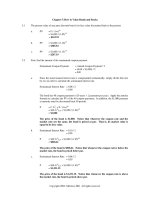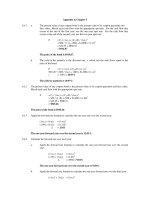Public-key cryptography (chapter 5) ppsx
Bạn đang xem bản rút gọn của tài liệu. Xem và tải ngay bản đầy đủ của tài liệu tại đây (354.43 KB, 29 trang )
Public-key cryptography 1
CHAPTER
CHAPTER
5
5
:
:
P
P
ublic
ublic
-
-
key
key
cryptography
cryptography
Rapidly increasing needs for flexible and secure transmission of
information require to use new cryptographic methods.
The main disadvantage of the classical cryptography is the need
to send a (long) key through a super secure channel before
sending the message itself.
IV054
In secret-key (symetric key) cryptography both sender and
receiver share the same secret key.
In public-key ryptography there are two different keys:
a public encryption key
and
a secret decryption key (at the receiver side).
2Public-key cryptograph
y
Basic idea: If it is infeasible from the knowledge of an encryption algorithm e
k
to
construct the corresponding description algorithm d
k
, then e
k
can be made public.
Toy example: (Telephone directory encryption)
Start: Each user U makes public a unique telephone directory td
U
to encrypt
messages for U and U is the only user to have an inverse telephone directory itd
U
.
Encryption: Each letter X of a plaintext w is replaced, using the telephone directory
td
U
of the intended receiver U, by the telephone number of a person whose name
starts with letter X.
Decryption: easy for U
k
, with an inverse telephone directory, infeasible for others.
IV054
Analogy:
Secret-key cryptography 1. Put the message into a box, lock it with a padlock and
send the box. 2. Send the key by a secure channel.
Public-key cryptography Open padlocks, for each user different one, are freely
available. Only legitimate user has key from his padlocks. Transmission: Put the
message into the box of the intended receiver, close the padlock and send the box.
Basic idea - example
3Public-key cryptograph
y
Public Establishment of Secret Keys
Public Establishment of Secret Keys
Main problem of the secret-key cryptography: a need to make a secure
distribution (establishment) of secret keys ahead of transmissions.
Diffie+Hellman solved this problem in 1976 by designing a protocol for secure key
establishment (distribution) over public channels.
IV054
Protocol: If two parties, Alice and Bob, want to create a common secret key, then
they first agree, somehow, on a large prime p and a primitive root q (mod p) and
then they perform, through a public channel, the following activities.
•
Alice chooses, randomly, a large 1 Ł x < p -1 and computes
X = q
x
mod p.
•
Bob also chooses, again randomly, a large 1 Ł y < p -1 and computes
Y = q
y
mod p.
•
Alice and Bob exchange X and Y, through a public channel, but keep x, y secret.
•
Alice computes Y
x
mod p and Bob computes X
y
mod p and then each of them
has the key K = q
xy
mod p.
An eavesdropper seems to need, in order to determine x from X, q, p and y from Y,
q, p, to have a capability to compute discrete logarithms, or to compute q
xy
from q
x
and q
y
, what is believed to be infeasible.
4Public-key cryptograph
y
MAN-IN-THE-MIDDLE ATTACK
MAN-IN-THE-MIDDLE ATTACK
The following attack by a man-in-the-middle is possible against the Diffie-Hellman
key establishment protocol.
IV054
1. Eve chooses an exponent z.
2. Eve intercepts q
x
and q
y
.
3. Eve sends q
z
to both Alice and Bob. (After that Alice believes she has received q
x
and Bob believes he has received q
y
.)
4. Eve computes K
A
= q
xz
(mod p) and K
B
= q
yz
(mod p) .
Alice, not realizing that Eve is in the middle, also computes K
A
and
Bob, not realizing that Eve is in the middle, also computes K
B
.
5. When Alice sends a message to Bob, encrypted with K
A
, Eve intercepts it,
decrypts it, then encrypts it with K
B
and sends it to Bob.
6. Bob decrypts the message with K
B
and obtains the message. At this point he has
no reason to think that communication was insecure.
7. Meanwhile, Eve enjoys reading Alice's message.
5Public-key cryptograph
y
Blom's key pre-distribution protocol
Blom's key pre-distribution protocol
allows to a trusted authority (Trent) to distributed secret keys to n (n - 1) / 2 pairs of n
users.
Let a large prime p > n be publically known. The protocol has the following steps:
1. Each user U in the network is assigned, by Trent, a unique public number r
U
< p.
IV054
2. Trent chooses three random numbers a, b and c, smaller than p.
3. For each user U, Trent calculates two numbers
a
U
= (a + br
U
) mod p, b
U
= (b + cr
U
) mod p
and sends them via his secure channel to U.
4. Each user U creates the polynomial
g
U
(x) = a
U
+ b
U
(x).
5. If Alice (A) wants to send a message to Bob (B), then Alice computes her key
K
AB
= g
A
(r
B
) and Bob computes his key K
BA
= g
B
(r
A
).
6. It is easy to see that K
AB
= K
BA
and therefore Alice and Bob can now use their
(identical) keys to communicate using some secret-key cryptosystem.
6Public-key cryptograph
y
Secure communication
Secure communication
with secret-key cryptosystems
with secret-key cryptosystems
without any need forsecret key distribution
(Shamir's no-key algorithm)
Basic assumption: Each user X has its own
secret encryption function e
X
secret decryption function d
X
and all these functions commute (to form a commutative cryptosystem).
IV054
Communication protocol
with which Alice can send a message w to Bob.
1. Alice sends e
A
(w) to Bob
2. Bob sends e
B
(e
A
(w)) to Alice
3. Alice sends d
A
(e
B
(e
A
(w))) = e
B
(w) to Bob
4. Bob performs the decryption to get d
B
(e
B
(w)) = w.
Disadvantage: 3 communications are needed (in such a context 3 is a much too
large number) .
Advantage: A perfect protocol for distribution of secret keys.
7Public-key cryptograph
y
Cryptography and Computational Complexity
Cryptography and Computational Complexity
Modern cryptography uses such encryption methods that no ``enemy'' can have
enough computational power and time to do encryption (even those capable to use
thousands of supercomputers for tens of years for encryption).
Modern cryptography is based on negative and positive results of complexity theory
- on the fact that for some algorithm problems no efficient algorithm seem to exists,
surprisingly, and for some of “small'' modifications of these problems, surprisingly,
simple, fast and good enough (randomized) algorithms do exist.
IV054
Integer factorization: Given n (= pq), find p, q - unfeasible.
There is a list of ”most wanted to factor integers''. Top current successes, using
thousands of computers for months.
(*) Factorization of 2
2^9
+ 1 with 155 digits (1996)
(**) Factorization of a “typical'' 155-digits integer (1999)
Primes recognition: Is a given n a prime? - fast randomized algorithms exist.
The existence of polynomial deterministic algorithms has been shown only in 2002
8Public-key cryptograph
y
Cryptography and Computational Complexity
Cryptography and Computational Complexity
IV054
Discrete logarithm problem: Given x, y, n, compute a such that y ≡ x
a
(mod n) - unfeasible.
Discrete square root problem: Given y, n, compute x such that y ≡ x
2
(mod n) - infeasible in general, easy if n is prime.
Knapsack problem: Given a knapsack vector X = (x
1
,…,x
n
) and
knapsack capacity c, find binary vector (b
1
,…,b
n
) such that
Problem is NP-hard in general, but easy if
∑
=
=
n
i
ii
cxb
1
.
∑
−
=
≤<>
1
1
.1 ,
i
j
ji
nixx
9Public-key cryptograph
y
One-way functions
One-way functions
Informally, a function F:N -> N is said to be one-way function if it is easily
computable - in polynomial time - but any computation of its inverse is infeasible.
A one-way permutation is a 1-1 one-way function.
easy
x f(x)
computation infeasible
IV054
( )( ) ( )( )
( )
.
1
1
c
r
n
xffxfAP <∈
−
A more formal approach
Definition A function f:{0,1}* → {0,1}* is called a strongly one-way function if the
following conditions are satisfied:
1. f can be computed in polynomial time;
2. there are c,
ε
> 0 such that |x|
ε
Ł |f(x)| Ł |x|
c
;
3. for every randomized polynomial time algorithm A, and any constant c > 0,
there exists an n
c
such that for n > n
c
Candidates: Modular exponentiation: f(x) = a
x
mod n
Modular squaring f(x) = x
2
mod n, n - a Blum integer
Prime number multiplication f(p, q) = pq.
10Public-key cryptograph
y
Trapdoor One-way Functions
Trapdoor One-way Functions
The key concept for design of public-key cryptosystems is that of trapdoor
one-way functions.
A function f :X → Y is trapdoor one-way function
•
if f and its inverse can be computed efficiently,
•
yet even the complete knowledge of the algorithm to compute f does not
make it feasible to determine a polynomial time algorithm to compute inverse
of f.
IV054
A candidate: modular squaring with a fixed modulus.
-
computation of discrete square roots is unfeasible in general, but quite easy if the
decomposition of the modulus into primes is known.
One way to design a trapdoor one-way function is to transform an easy case of a
hard (one-way) function to a hard-looking case of such a function, that can be,
however, solved easily by those knowing how the above transformation was
performed.
11Public-key cryptograph
y
Example - Computer passwords
Example - Computer passwords
A naive solution is to keep in computer a file with entries as
login CLINTON password BUSH,
that is with logins and corresponding passwords. This is not sufficiently safe.
IV054
A more safe method is to keep in the computer a file with entries as
login CLINTON password BUSH one-way function f
c
The idea is that BUSH is a “public'' password and CLINTON is the only one
that knows a “secret'' password, say MADONA, such that
f
c
(MADONA) = BUSH
12Public-key cryptograph
y
LAMPORT’s ONE-TIME PASSWORDS
One-way functions can be used to create a sequence of passwords:
•
Alice chooses a random w and computes, using a one-way
function h, a sequence of passwords
w, h(w), h(h(w)),…,h
n
(w)
•
Alice then transfers securely (??????) ``the initial secret’’ w
0
=h
n
(w)
to Bob.
•
The i-th authentication, 0 < i < n+1, is performed as follows:
Alice sends w
i
=h
n-i
(w) to Bob
Bob checks whether w
i-1
=h(w
i
).
When the number of identifications reaches n, a new w has to be
chosen.
13Public-key cryptograph
y
General knapsack problem - unfeasible
KNAPSACK PROBLEM: Given an integer-vector X = (x
1
,…,x
n
) and an integer c.
Determine a binary vector B = (b
1
,…,b
n
) (if it exists) such that XB
T
= c.
IV054
Knapsack problem with superincreasing vector – easy
Problem Given a superincreasing integer-vector X = (x
1
,…,x
n
) (i.e.
and an integer c,
determine a binary vector B = (b
1
,…,b
n
) (if it exists) such that XB
T
= c.
Algorithm - to solve knapsack problems with superincreasing vectors:
for i ← n downto 2 do
if c ł 2x
i
then terminate {no solution}
else if c > x
i
then b
i
← 1; c ← c – x
i
;
else b
i
= 0;
if c = x
1
then b
1
← 1
else if c = 0 then b
1
← 0;
else terminate {no solution}
Example X = (1,2,4,8,16,32,64,128,256,512) c = 999
X = (1,3,5,10,20,41,94,199) c = 242
)
1,
1
1
>>
∑
−
=
ixx
i
j
ji
14Public-key cryptograph
y
KNAPSACK ENCODING - BASIC IDEAS
KNAPSACK ENCODING - BASIC IDEAS
Let a (knapsack) vector
A = (a
1
,…,a
n
)
be given.
Encoding of a (binary) message B = (b
1
, b
2
,…,b
n
) by A is done by the
vector/vector multiplication:
AB
T
= c
and results in the cryptotext c
IV054
Decoding of c requires to solve the knapsack problem for the instant given by
the knapsack vector A and the cryptotext c.
The problem is that decoding seems to be infeasible.
Example
If A = (74, 82,94, 83, 39, 99, 56, 49, 73, 99) and B = (1100110101) then
AB
T
=
15Public-key cryptograph
y
Another view of the knapsack problem
Another view of the knapsack problem
Each knapsack vector A = (a
1
,…,a
n
)
defines an integer valued
knapsack-function
specified by
Example A
0
= (43,129,215,473,903,302,561,1165,697,1523)
f
A0
(364) = f
A0
(0101101100) = 129 + 473 + 903 + 561 + 1165 = 3231
IV054
( ) ( )
. if
2121
xxxfxf
AA
≠≠
{ }
Nxxf
n
A
→<≤ 20|:
( )
∑
−
=
1
isxoftionrepresenta
binarytheinbitthi
iA
axf
Unambiguity of knapsack systems
For unambiguity of the decryption of the knapsack cryptosystems with knapsack
vector A, it is important that
Example: If A = (17,103,50,81,33), then 131=17+33+81=50+81
Snd therefore for cryptotexts:
(131,33,100,234,33)
SAUNA FAUNA
two plaintexts are obtained
16Public-key cryptograph
y
Design of knapsack cryptosystems
Design of knapsack cryptosystems
1. Choose a superincreasing vector X = (x
1
,…,x
n
).
2. Choose m, u such that m > 2x
n
, gcd(m, u) = 1.
3. Compute u
-1
mod m, X '= (x
1
’
,…,x
n
'
), x
i
’
= ux
i
mod m.
diffusion
confusion
IV054
Cryptosystem: X' - public key
X, u, m - trapdoor information
Encryption: of a binary vector w of length n: c = X' w
Decryption: compute c‘ = u
-1
c mod m
and solve the knapsack problem with X and c'.
Lemma Let X, m, u, X', c, c' be as defined above. Then the knapsack problem
instances (X, c') and (X', c) have at most one solution, and if one of them has a
solution, then the second one has the same solution.
Proof Let X'w = c. Then
c‘ ≡ u
-1
c ≡ u
-1
X'w ≡ u
-1
uXw ≡ Xw (mod m).
Since X is superincreasing and m > 2x
n
we have
(X w) mod m = X w
and therefore c‘ = Xw.
17Public-key cryptograph
y
Design of knapsack cryptosystems
Design of knapsack cryptosystems
Example X = (1,2,4,9,18,35,75,151,302,606)
m = 1250, u = 41
X‘ = (41,82,164,369,738,185,575,1191,1132,1096)
In order to encrypt an English plaintext, we first encode its letters by 5-bit numbers
_ - 00000, A - 00001, B - 00010,… and then divide the resulting binary strings into
blocks of length 10.
Plaintext: Encoding of AFRICA results in vectors
w
1
= (0000100110) w
2
= (1001001001) w
3
= (0001100001)
Encryption: c
1’
= X'w
1
= 3061 c
2’
= X'w
2
= 2081 c
3’
= X‘w
3
= 2203
Cryptotext: (3061,2081,2203)
IV054
Decryption of cryptotexts: (2163, 2116, 1870, 3599)
By multiplying with u
–1
= 61 (mod 1250) we get new cryptotexts (several new c’)
(693, 326, 320, 789)
and in the binary form solutions B of equations XB
T
=c’ have the form
(1101001001, 0110100010, 0000100010, 1011100101)
that is the resulting plaintext is:
ZIMBABWE
18Public-key cryptograph
y
Story of the Knapsack
Story of the Knapsack
Invented: 1978 - Ralp C. Merkle, Martin Hellman
Patented: in 10 countries
Broken: 1982: Adi Shamir
New idea: iterated knapsack cryptosystem using hyper-reachable vectors.
Definition A knapsack vector X '= (x
1'
,…,x
n'
) is obtained from a knapsack vector
X=(x
1
,…,x
n
) by strong modular multiplication if
X’
i
= ux
i
mod m, i = 1,…,n,
where
and gcd(u, m) = 1. A knapsack vector X' is called hyper-reachable, if there is a
sequence of knapsack vectors X = x
0
, x
1
,…,x
k
= X ‘,
where x
0
is a super-increasing vector and for i = 1,…,k} and x
i
is obtained from x
i-1
by
a strong modular multiplication.
Iterated knapsack cryptosystem was broken in 1985 - E. Brickell
New ideas: dense knapsack cryptosystems. Density of a knapsack vector: X=(x
1
,
…,x
n
) is defined by
Remark. Density of super-increasing vectors is
IV054
∑
=
>
n
i
i
xm
1
2
( )
{ }( )
nix
n
xd
i
≤≤
=
1|maxlog
1−
≤
n
n
19Public-key cryptograph
y
Breaking knapsack
Breaking knapsack
Basic ideas of Shamir's polynomial time algorithm (in the length of the knapsack
vector) to break knapsack cryptosystems.
Assumption: there is a d > 1 such that modulus m has [dn] bits and elements a
i
,
1ŁiŁn, of a superincreasing vector, have [dn] – 1 – n + i bits.
(This implies that A is a superincreasing vector and
(Original suggestion: d = 2,n = 100.)
IV054
∑
=
>
n
i
i
am
1
.
)
( )
∑
=<=>
−
1,'gcd ,' mod ,'
1
tmmmutam
i
N , ∈j
b
jm
i
m
b
i
x
m/b
i
m x
Key observation: Given a knapsack vector B, which was obtained from a super-
increasing vector A through a strong modular multiplication using m and u, it is not
important for successful cryptoanalysis to find original A, m, u. It is enough to find a
pair (m‘ ,u') such that (1) the vector A' obtained is superincreasing
(2)
Such a pair is called a trapdoor pair.
To find a trapdoor pair one can proceed as follows:
One consider functions b
i
x mod m,1 Ł i Ł n
Minimums are in points (discontinuation points)
sawtooth curves
20Public-key cryptograph
y
Breaking knapsack
Breaking knapsack
We need to find out t and m such that:
a
i
= b
i
t mod m
and (a
1
,…,a
n
) is a superincreasing vector.
Since a
1
has to be very small comparing to m, t has to be close to some of the
minima of the b
1
-graph!
Similarly t has to be close to some minimum of the b
2
-graph.
This implies that two minima of the b
1
and b
2
-graphs must be close to one another.
Similarly we can consider more b
i
-graphs.
The fact that the trapdoor pair value of t is close to a minimum on each b
i
-graph
implies that all these minima are close to one another.
Thus, instead of trying to find t itself, we try to find out “accumulation points'' of the
minima of b
i
-graphs.
This amounts to constructing a small interval containing a minimum of each b
i
-
graph, and from this to find a trapdoor value of t.
Experiments show that it suffices to analyze only four b
i
-graphs to get a desirable
small interval containing t.
The task is now to express the above ideas in terms of inequalities.
IV054
21Public-key cryptograph
y
Breaking knapsack
Breaking knapsack
The first problem is that also m is unknown. This is easy to deal with.
We reduce the size of figures for b
i
-graphs so m becomes 1. This does not change
which of the minima are close to another.
The algorithm for finding a trapdoor pair consists of two parts:
1. Candidates are found for an integer p such that the p-th minimum of the b
1
-curve
is an accumulation point we are looking for.
IV054
2. Candidates are tests one by one. One of the candidates has to succeed.
One problem is that the first stage may produce too many candidates.
To deal with this problem an integer r is fixed in advance and if the first stage
produces more than r candidates the algorithm terminates and reports failure.
22Public-key cryptograph
y
KNAPSACK CRYPTOSYSTEM - COMMENTS
KNAPSACK CRYPTOSYSTEM - COMMENTS
The term “knapsack'' in the name of the cryptosystem is quite misleading.
By the Knapsack problem it is mostly understood the following problem:
Given n items with weights w
1
, w
2
,…, w
n
and values v
1
, v
2
,…, v
n
and a knapsack limit
c, the task is to find a bit vector (b
1
, b
2
,…, b
n
) such that
and is as large as possible.
IV054
∑
=
≤
n
i
ii
cwb
1
∑
=
n
i
ii
vb
1
The term subset problem is usually used for the problem used in our construction of
the knapsack cryptosystem. It is well-known that the decision version of this
problem is NP-complete.
Sometimes, for our main version of the knapsack problem the term Merkle-
Hellmman (Knapsack) Cryptosystem is used.
23Public-key cryptograph
y
McEliece Cryptosystem
McEliece Cryptosystem
McEliece cryptosystem is based on a similar design principle as the
Knapsack cryptosystem. McEliece cryptosystem is formed by
transforming an easy to break cryptosystem into a cryptosystem that is
hard to break because it seems to be based on a problem that is, in
general, NP-hard.
The underlying fact is that the decision version of the decryption
problem for linear codes is in general NP-complete. However, for
special types of linear codes polynomial-time decryption algorithms
exist. One such a class of linear codes, the so-called Goppa codes,
are used to design McEliece cryptosystem.
Goppa codes are [2
m
, n - mt, 2t + 1]-codes, where n = 2
m
.
(McEliece suggested to use m = 10, t = 50.)
IV054
24Public-key cryptograph
y
McEliece Cryptosystem
McEliece Cryptosystem
- DESIGN
- DESIGN
Goppa codes are [2
m
, n - mt, 2t + 1]-codes, where n = 2
m
.
Design of McEliece cryptosystems. Let
•
G be a generating matrix for an [n, k, d] Goppa code C;
•
S be a k × k binary matrix invertible over Z
2
;
•
P be an n × n permutation matrix;
•
G‘ = SGP.
Let P = (Z
2
)
k
, C = (Z
2
)
n
, K = (G, S, P, G‘).
G' is made public, G, S, P are kept secret.
IV054
Encryption: e
K
(w, e) = wG‘ + e, where e is a binary vector of length n and weight t.
Decryption of a cryptotext c = wG’+e ∈ (Z
2
)
n
.
1. Compute c
1
= cP
–1
=wSGPP
–1
+ eP
–1
= wSG+eP
-1
2. Decode c
1
to get w
1
= wS
,
3. Compute w = w
1
S
-1
25Public-key cryptograph
y
COMMENTS on McELIECE CRYPTOSYSTEM
COMMENTS on McELIECE CRYPTOSYSTEM
1. Each irreducible polynomial over Z
2
m
of degree t generates a Goppa code with
distance at least 2t + 1.
IV054
2. In the design of McEliece cryptosystem the goal of matrices S and C is to modify
a generator matrix G for an easy-to-decode Goppa code to get a matrix that looks
as a general random matrix for a linear code for which decoding problem is NP-
complete.
3. An important novel and unique trick is an introduction, in the encoding process,
of a random vector e that represents an introduction of up to t errors - such a
number of errors that are correctable using the given Goppa code and this is the
basic trick of the decoding process.
4. Since P is a permutation matrix eP
-1
has the same weight as e.
5. As already mentioned, McEliece suggested to use a Goppa code with m=10 and
t=50. This provides a [1024, 524, 101]-code. Each plaintext is then a 524-bit string,
each cryptotext is a 1024-bit string. The public key is an 524 × 1024 matrix.
6. Observe that the number of potential matrices S and P is so large that
probability of guessing these matrices is smaller that probability of guessing correct
plaintext!!!
7. It can be shown that it is not safe to encrypt twice the same plaintext with the
same public key (and different error vectors).









